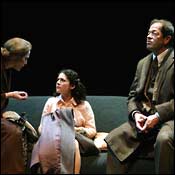
One might salute A Bad Friend as Jules Feiffer’s most ambitious drama to date. In it, he has tried to fuse autobiography, relationships, and politics into some kind of amalgam. Out of himself and his sister he has fashioned Rose, a bright Jewish 18-year-old maturing in Brooklyn Heights in 1953, and resisting the communism of her plodding parents, Shelly and Naomi, and of her smooth uncle, Morty, a successful Hollywood screenwriter who sneaks leftist propaganda into his movies.
The so-called Jewish Doctors’ Plot, bloodily “suppressed” by Stalin, proves a gross miscarriage of justice and plants doubts in some fellow travelers who like to call themselves, euphemistically, Progressives. The less fanatical Shelly is shaken, but his dominating spouse, Naomi, will hear nothing against the Party and her hero, Stalin, and purblindly insists that he was already dead when the injustice was perpetrated.
The main plot concerns Rose, who likes to go sketching on the Esplanade, where she meets Emil, an amiable but mysterious older man who keeps photographing and painting the Manhattan skyline. Emil becomes her father surrogate. But she is also regularly accosted by the smarmy and prying Fallon, clearly an FBI agent trying to get her to rat on family and friends. In Rose’s relations with these two opposite forces, the play abandons realism and veers into something like symbolism or, perhaps more properly, cartooning, which in an otherwise credible context rings too glib and false.
There is one other, overarching problem: What exactly is Feiffer trying to say with A Bad Friend? Bit by bit, it makes scrutable points, but what is the meaning of the whole? One thing is certain: We have heard all this, less confusedly, before. Jerry Zaks has ably directed a fine cast, with the exception of Jonathan Hadary (Shelly), who ruins whatever he touches. But even Joe McCarthy would have had to declare Larry Bryggman, Mark Feuerstein, David Harbour, the wonderful Jan Maxwell, and the highly promising Kala Savage utterly unimpeachable. Douglas Stein’s set boasts a terrific stagewide mural of the Manhattan skyline, William Ivey Long’s costumes capture the period, and Paul Gallo’s lighting projects some interesting, though somewhat arbitrary, abstract designs. There are funny Feiffer lines here, but it is all news half a century too late for usefulness.
In Kate Robin’s Intrigue With Faye, two superficially glamorous and profoundly sophomoric lovers—unlikely therapist Lissa and documentary filmmaker Kean—find they can’t trust each other out of sight. How the self-righteous narcissist and the philandering egoist could have lasted together even this long is a mystery. To allay their reciprocal suspicions, they devise an improbable scheme of videotaping their every moment apart and then critically viewing the rather ambiguous tapes.
The outcome is a schizoid show, to be viewed simultaneously on an outsize video screen and a well-nigh dwarfed stage—an effect midway between reading a palimpsest and watching a two-ring circus. There is a certain TV slickness in both writing and production; indeed, Robin is a writer-producer on Six Feet Under. Jim Simpson has efficiently directed a very proficient Julianna Margulies, who makes Lissa more appealing than she is written, and an adequate Benjamin Bratt, who, if not much else, is a movie hunk. The actors to envy are the six who appear only on video; they give catchy cameo performances and are spared the discomfort of hearing and rehearing (the tapes are continually rewound and replayed) dialogue that hardly bears repetition.
Theater Listings
• Openings and Closings
• Broadway Shows
• Off-Broadway Shows
• Off-Off-Broadway
A Bad Friend
By Jules Feiffer; staged
by Jerry Zaks.
Intrigue With Faye
By Kate Robin; staged
by Jim Simpson.